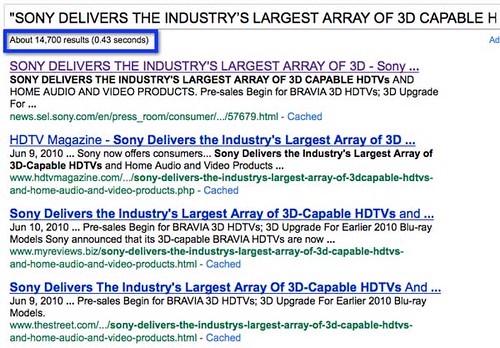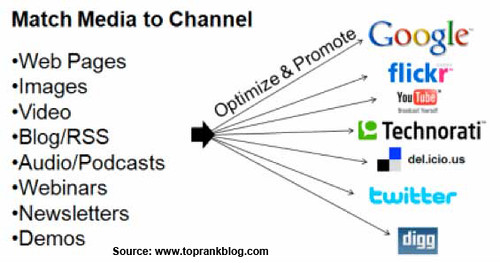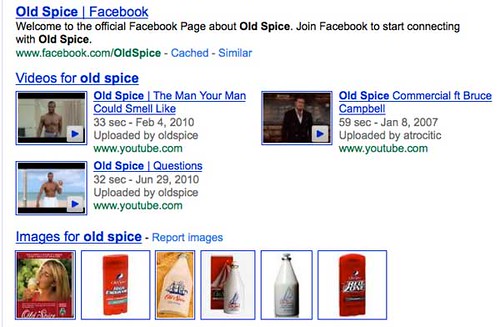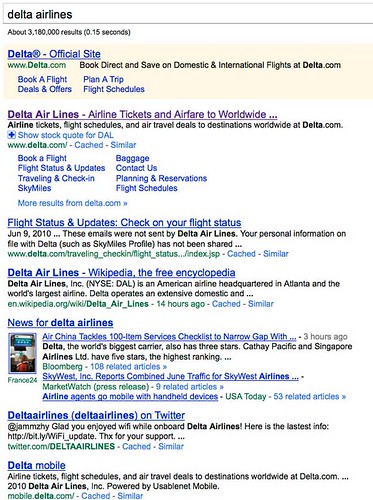The integration of SEO and Social Media should be as natural as a peanut butter and jelly. While a natural fit, few companies are even thinking of having these teams meet let along work together. Yes, many SEO teams have created some best practices and thrown them over the fence to the many Social Media task forces and teams that are sprouting like weeds but few have really integrated them. Even few have looked beyond the collaborative value of link building.
In the following paragraphs, I will try to illustrate why these two practices should be more tightly integrated.
Inbound Links
The desire for lot of high quality and relevant links is the main reason us SEO folks follow around the Social Media teams like lost puppies. Links have a pretty significant influence your rankings for specific search terms and the Social Media team can be on of our biggest allies in getting them but we need to ensure they have the knowledge and data integrated into their social media workflow.
Social Media teams are busy cranking out content on blogs, working their influencers and tweeting relevant tips, ideas and content that creates buzz, traffic and increased awareness but what if they use a less than optimal page, flowery words, and “click here†as the anchor text? That is more common than you think which is why we need to have collaboration to make sure every precious link and piece of UGC created ads incremental value beyond the social media uplift.
One key thing to remember is not to get too excited about the bounty of links that can come from Social Media site. Unfortunately, many of the biggest social-media sites don’t actually pass along any direct search benefit since they often apply a “nofollow†attribute to their outgoing links. This tells the search engines that they can’t really vouch for this link so don’t transfer any value or “link juice†to this page. This is the norm for major social sites such as Facebook, Twitter, YouTube, Digg, Flickr as well as the comments sections of some of the most common blog platforms.
While these big sites won’t pass you any value, don’t get discouraged. We want the exposure on these sites to introduce our site and content to the visitors and participants in these sites. Once they do click through and visit our site they will often add links or other relevant information to their social media sites and blogs that will pass value to us.
Many companies are adopting short URL services such as bit.ly or developing their own. If you do use these shortened URL’s you want to make sure that they are using a 301 redirect to send people from the short URL to your site. By using a 301 you can often pick up some value from these links and tweets especially if that URL is taken and added into a blog post or website.
Consumer Intersection and Engagement
Understanding the key points of intersection with your target market is essential. We learned from Forrester’s Social Technographics profile, published in Q4 2009, that identified 70% of social media users as ‘spectators’ – “those who actively read blogs, tweets, customer reviews and content in forums as part of their regular online activity.†They went on to state that 33% “regularly engaging in conversation, and this conversation hasthe ability to live on indefinitely within the World Wide Web.â€
With 70% consuming and 1/3 participating it is essential that we as search marketers need to understand how consumers find these “hubs of conversation.†We further need to ensure that they are aware and, whenever possible, talking about our brand. This will require an unparalleled level of participation and engagement from brands than they have been willing to undertake previously.
Most of us have learned to work with our PR teams to have them integrate keywords and relevant anchor text into the press releases but few have really looked at the bigger picture and the downstream influence of these releases especially in Social Media. Take for example Sony’s announcement recently on the large selection of 3d-capable HD TV’s.
To date this press release has been picked up over 14,000 times with the exact subject line they sent it out as. The sites referencing it range from obscure review sites to major news outlets. The unfortunate face is there is only 1 link in the whole press release but fortunately that is to the home page of the 3d product category. The moral of the story is this release was picked up as is and then places on 14,000 sites with many of them being highly relevant such as Engadget and the Consumer Reports blog. In this case, this release generated over 600 new links to this category page, which is the Sony poster child for 3D TV but it has also resulted in a significant amount of ShelfSpace and intersections with people interested in 3D Televisions.
Digital Asset Optimization
This is where us on the SEO side get to help the new kids in social media. Their goal is to generate as much “earned media†as possible. We fully support that and want to make sure as much of that newly minted content ends up in the search results and is indexed as possible. This is why all Marketers need to consider their “content enablement strategy†to understand how they will leverage all the digital touch points with their target market. This takes shape in three ways:
Uniform and Engaging Messages – You need to understand how to do it uniformly while providing relevant, useful and engaging messages to compel them to spread the word within their own individual networks. With an understanding of this ecosystem of awareness, Marketers need to ensure their digital assets are effectively optimized and distributed to the widest points on the net possible. Search is the logical team to help ensure this happens. They already manage the XML site maps and feed content into the search engines making it relatively easy for them to also integrate video, image, news and mobile feeds into that process and monitoring their performance.
Identify and Target the Ecosystem – Second to identifying the ecosystem is ensuring we have a key destination page within the site that will last beyond the any promotion or campaign. This page needs to be identified and shared with all stakeholders to ensure we get the widest distribution of the central page and the assets and messages contained therein. For many companies, this type of content mapping has already been done by the SEO team and just needs to be adapted for Social Media and PR uses. A well-organized SEO program will often have dozens, if not hundreds, of keywords that they have matched to highly relevant pages. By leveraging this list we will nearly ensure that we are pointing to the optimal page and use the keywords as anchor text. This uniformity ensures we get not only relevant inbound links but offer a common customer experience across all digital media.
Digital Asset Optimization – This is a key element where we are starting to get more alignment. This concept was introduced by Lee Oden at Top Rank Blog a few years ago in his article Extending SEO With Digital Asset Optimization that talked about optimizing all of your digital assets and ensuring they are findable in all search channels especially those beyond search engines.
Once you have alignment of optimized assets and the specific landing page we can start the process of submission and ensuring the assets are found, indexed and ranked in the major aggregation portals as shown below.
By enabling the submission and indexing in as many places as possible each of them offers incremental opportunities themselves but as more of them get indexed they in aggregate, foster a significant opportunity to dominate the shelfspace of various search engines.
Search Results ShelfSpace
This is a term I coined many years ago when working for a company that has multiple sites in the same category. The GSI team and I further perfected this approach while working on various categories at P&G. The goal then was to get as many of the brand pages indexed as possible on the first page in order to dominate the results the same as they would the physical shelf of a local supermarket – think Kellogg’s cereal.
As you can imagine, this would only work if you had a bunch of sites and you could get them to make the changes since the engines only allowed a maximum of two listings per domain in the search results. Yes, for the lucky, you could get benefit from multiple subdomains or international site but that was killed by Google.
Today we can do this a lot easier by leveraging the multitudes of social media sites. It works brilliantly for domains and brands but is a bit harder for specific categories but it is not impossible. This is where the collaboration and cooperation is the most important to make sure we are feeding the most relevant information that will help us get into the news, natural listings and the ever changing “real time†search results.
A great example of this is Old Spice they have all but 1 of the listing with a combination of their TV ads, images, news and specialty sites
Reputation Management
For those thinking out of the box, the concept of dominating the SERP ShelfSpace should be sparking ideas and does have a significant opportunity in your online reputation management toolbox. Many companies struggle with “sucks sites†and those pesky negative blog posts which seem to make their way to the top of the search results for brand or product searches.
As I mentioned, ShelfSpace optimization was originally developed for companies like P&G to get multiple brands from the same company on the first page of the search results. Social media has made it been a great way to help dominate the ShelfSpace for a single brand company. By using the key social media outlets you have a great opportunity to push all or most of the negative listings off the first page for your brand or product name.
The overused example of the need for reputation management in many presentations was “Delta Airlines†and the infamous “Delta Sucks†site. That site and the other blog-based detractors are now gone, replaced by Delta’s Twitter account, mobile site, and their news site in addition to Wikipedia and a large block of “new†most of which was generated by Delta
To make this work you have to participate in Social Media and leverage the optimization tactics to ensure the right use of names, keywords, tagging and of course, brand and keyword rich content.
Voice of the Consumer
Another key value of the integration is the shared data. Search gives you a lens into what people are “looking for†and Social Media conversation mining gives you insight into what they are actually talking about. Looking at both pieces of data can often find key emerging opportunities to develop content along specific conversations people are having. This will create additional content elements that you can use to intersect with consumers at the critical point of interest where you have the best opportunity to influence the next step in their purchase behavior.
Imagine if the content team could prioritize content best on not only this historical demand from search query volume but also real time input from social media monitoring.
Search Rankings Identify Relevance and Influence
Bloggers are especially important to identify and classify by their relative influence as well as their organic rankings for relevant terms. An often discarded by-product of ranking reports is the “other listings†that are in the top 10. If we look at these results we can often find blogs or other social media participants that are contextually relevant enough to show up on the top 10 listings in the search engines. These influencers with a high ranking blog will help increase the potential consideration from visitors since they are often looking for recommendations and reviews from places other than from the manufacturer.
Once we indentify these relevant blog and social media sites we can reach out to these bloggers who are always looking for new content. Once we reach out to them with quality information they will often register for your RSS feeds, press releases, and social media mentions of companies in the product area or vertical they are writing about. This can be the gift that keeps on giving since they will then be feeding them selves with this optimized content being pushed via these other distribution
As has always been said about SEO it is the content that matters from both a ranking as well as getting links. The best thing you can do is create relevant content and participate in the conversation




Hi Lee, yep, great image! For those that have not read the article check out Lee’s “before its time” recommendations on Digital Asset optimization